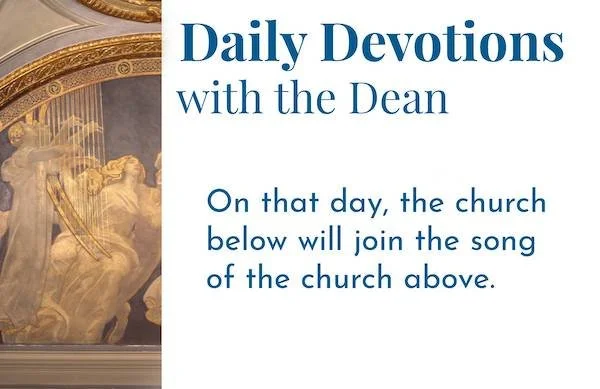Tuesday • 11/7/2023 •
Tuesday of the Twenty-third Week After Pentecost (Proper 26)
This morning’s Scriptures are: Psalm 61; Psalm 62; Nehemiah 12:27–31a,42b–47; Revelation 11:1–19; Matthew 13:44–52
This morning’s Canticles are: following the OT reading, Canticle 13 (“A Song of Praise,” BCP, p. 90); following the Epistle reading, Canticle 18 (“A Song to the Lamb,” Revelation 4:11; 5:9–10, 13, BCP, p. 93)
Welcome to Daily Office Devotions, where every Monday through Friday we draw insights from that day’s Scripture readings, as given in the Book of Common Prayer. I’m Reggie Kidd, and I’m grateful to be with you. This Tuesday in the Season After Pentecost our readings come from Proper 26 of Year 1 in the Daily Office Lectionary.
Revelation 11: the church protected and prevailing
Looking back and looking ahead. In Revelation 10, John is instructed to eat a little scroll. It is sweet and bitter, because its message is both good news and bad news, both blessing and curse. Accordingly, from Revelation 12 to the end of the book, Revelation will forecast the destiny of two symbolic women: the “bride of Christ” for whom a wedding banquet is being prepared in a new heaven and new earth (Revelation 19–22), and “the great whore [of Babylon] who is seated on many waters, with whom the kings of the earth have committed fornication, and with the wine of whose fornication the inhabitants of the earth have become drunk” (Revelation 17:1b–2). Two women, representing humanities with two destinies. The book’s message to us is: choose carefully which future is yours.
Image: "Heaven" by Boston Public Library is licensed under CC BY-NC-ND 2.0
Measuring time. Here in Revelation 11, in preparation for the unfolding of the drama contrasting the destinies of the bride of Christ and the whore of Babylon, John is given perspective on God’s provision and protection during “three-and-a-half years” of intense tribulation (Revelation 11:3).
In their juxtaposition in the book of Revelation, two important numbers represent the duration of the church’s existence between Christ’s two comings: three-and-a-half years, and a thousand years. These numbers are, I believe (and it is a matter of interpretation), symbolic rather than literal. The church age is at one and the same time a short period in which Christians testify despite strong resistance (Revelation 11:3; 12:6,14; 13:5), and also a long period in which they share in Christ’s reign as a kingdom of priests (Revelation 20:2).
Measuring the temple. Some interpreters believe the measuring of the temple in Revelation 11 has in view either the physical temple that no longer stands in Jerusalem or a temple that will one day be rebuilt there. I do not believe either is in view. I believe God is assuring John and readers like you and me that God protects and preserves the faithful who dwell in the new temple that has been under construction since Christ rose from the dead (John 2:19–20; 1 Corinthians 3:9; 6:19; Ephesians 2:19–22; Hebrews 3:6; 1 Peter 2:4–5). Right now, God dwells among his people, and despite the storm of tribulation through which they live, he neither abandons them nor forsakes them. Thus, Revelation 11:4–10 promises “oil” to keep the “lamps” of the temple lit, and power and authority to the words of the witnesses.
What lies ahead: martyrdom and vindication. The New Testament consistently pictures a day that lies ahead of us when, by God’s permission, there will be something that New Testament theologian Herman Ridderbos calls “an explosion of evil.” In his epistles, John refers to “the Antichrist” and “the spirit of Antichrist” (1 John 2:18,22; 4:3; 2 John 7). In Revelation, John describes “the war against the Lamb and his people,” empowered by the unleashed dragon Satan (Revelation 12:9; 20:7–9a), effected through the great beast that emerges from the sea (Revelation 13), and inflaming all those in thrall to the whore of Babylon.
In Revelation 11, John gets a preview of how challenging those days will be for God’s people: “When they have finished their testimony, the beast that comes up from the bottomless pit will make war on them and conquer them and kill them” (Revelation 11:7). With the unleashing of Satan, the rise of the beast, and the attack of the armies of the whore of Babylon, an intense season of martyrdom lies ahead. But that season of intense suffering will be limited to a symbolic “three and a half days,” and will be followed by Christ’s return and our resurrection. Vindication will come with the sounding of the seventh trumpet, the opening of God’s temple in heaven, a raining down of a storm of judgment against all lawlessness (Revelation 11:15–19), the return of Christ in glory (Revelation 19:11–21), and the establishment of God’s final reign (especially Revelation 20:9b–22:21). On that day, the church below will join the song of the church above: “The kingdom of the world has become the kingdom of our Lord and of his Messiah, and he will reign forever and ever” (Revelation 11:15).
Meanwhile, while John is told not to write down everything he sees (Revelation 10:4), he is told to write this down for us: “The one who overcomes I will make a pillar in the temple of my God … The one who overcomes I will grant to sit with me on my throne … The one who overcomes will inherit these things, and I will be their God and they will be my son” (Revelation 3:12,21; 21:7, my translation).
Be blessed this day,
Reggie Kidd+



